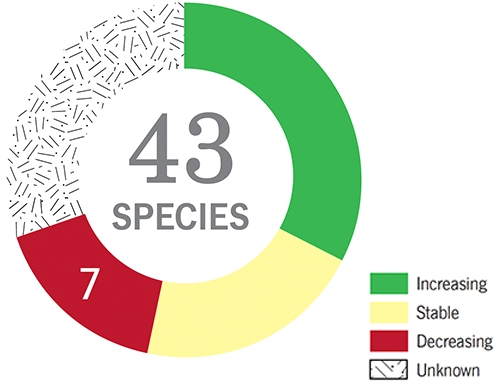Although New Hampshire has a short coastline, our nearshore and offshore waters provide critical habitat to over 40 species of birds. Most of them do not breed here, and these off-season visitors come from places as far flung as the Canadian tundra or remote islands in the southern Atlantic Ocean. Representative groups include sea ducks (eiders, scoters), auks (e.g., guillemots and puffins), gulls and terns, loons, shearwaters and petrels, and cormorants. Most eat marine invertebrates or fish.

Least Tern
Roseate Tern
Common Tern
Arctic Tern
Common Loon (non-breeding)
Common Eider
Black Guillemot
Gulls
Shearwaters
Northern Gannet
Double-crested Cormorant
Roughly half the seabirds occurring in New Hampshire are stable or increasing, although a significant portion of the remainder have unknown trends. On a global scale, however, this is one of the most imperiled groups of birds, often because they are extremely sensitive at their nesting areas.
Many species are island nesters, making them vulnerable to threats as diverse as introduced predators and rising sea levels. Climate change also has the potential to alter the marine food webs on which they depend, and pollution – both from oil and discarded plastics – is pervasive and hard to control. For the several species that are long-distance migrants, all these threats are compounded across their complex annual life cycles.
We have done a good job of protecting the seabirds that nest in New Hampshire, and oil spill response plans exist for the entire coast and Great Bay. Climate change and plastics pollution operate on a global scale and require broad-reaching actions, but simple things like changing buying habitats to reduce waste can make a difference in local communities.
Ocean birds that don’t nest in New Hampshire are poorly monitored in their non-breeding season, and as a result we don’t know how populations are doing when they visit our waters. At the same time, we lack detailed data on how threats such as plastic affect most of these species.
Contact Headquarters

National Wildlife Federation Affiliate
Website By CleverLight
Information for the species profiles on this website was compiled from a combination of the sources listed below.
The Birds of New Hampshire. By Allan R. Keith and Robert B. Fox. 2013. Memoirs of the Nuttall Ornithological club No. 19.
Atlas of the Breeding Birds of New Hampshire. Carol R. Foss, ed. 1994. Arcadia Publishing Company and Audubon Society of New Hampshire
Birds of the World. Various authors and dates. Cornell Laboratory of Ornithology.
Data from the Breeding Bird Survey
Data from the Christmas Bird Count